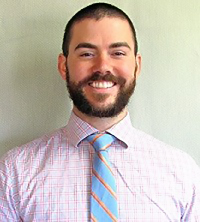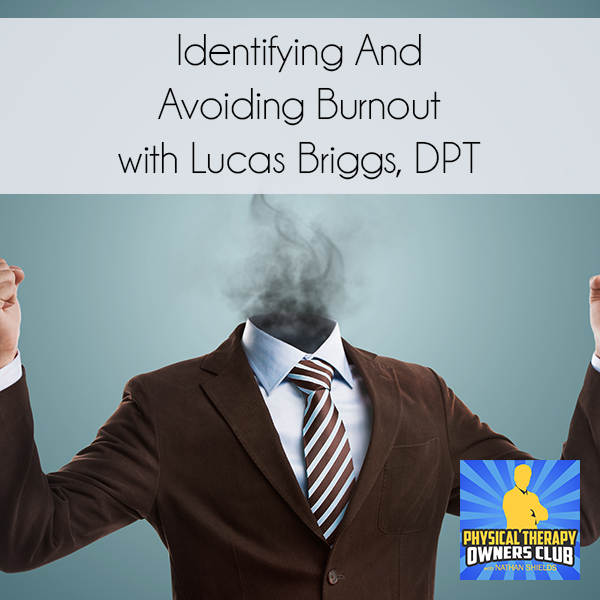
—
Listen to the podcast here:
Identifying And Avoiding Burnout with Lucas Briggs, DPT
On this episode, I’m talking with Lucas Briggs, a physical therapist out of Grand Rapids, Michigan. I came across Lucas’ article in July 2019 in Impact Magazine, where he wrote about identifying burnout. For someone relatively young in the profession, it’s interesting to me that he had some insight about burnout. I’m seeing the topic come up more in social media and also from general perception where you don’t see a lot of older physical therapists, they’ll run in hard. You might see an older dentist or older family practitioner or even a surgeon. You don’t see a lot of that in physical therapy. I’m sure it’s multi-factorial, but nonetheless, we don’t see it a lot. I also have come across younger physical therapy owners that complain about burnout.
I thought it would be a great opportunity to talk to him about his insight and what he does since he’s had to deal with it himself, what he does to manage burnout and stress, not only in his own career but also in the people that he works with. For someone who’s relatively young in the profession to recognize it and also be mindful of it as he’s working with others, I think is beyond his years. I thought it would be valuable for all of us to take a look a little bit about what might be causing our burnout and identify those factors and try to figure out what we can do to manage it so that we can maintain our energy, maintain our passion, maintain our vision and still focus on others and have the energy to do so. I think it’s invaluable for us individually, but also as a profession to recognize that this is happening. Let’s get to the interview.
—
I’ve got Lucas Briggs, Clinic Director and dad from Grand Rapids, Michigan He did an article in Impact Magazine about burnout with physical therapists and I thought it was somewhat timely. I’m noticing some of those things coming up from the WebPT report regarding the physical therapy profession. In general, things that I’m noticing about the profession and how there seems to be a significant amount of people that do complain about burnout and the challenges with our profession. I wanted to thank you, Lucas, for coming on and joining me.
It’s my pleasure. Thanks for having me.
You did an article in Impact Magazine about identifying burnout. You had a little bit of a burnout experience yourself, but I’d like to learn a little bit more about you and if you could share with the audience about your story, where you came from and where you’re at professionally.
I did my graduate school training in Grand Rapids, Michigan at Grand Valley State University. It’s where I met with my wife. She’s here. Her family is from here. We took a little adventure out to Washington where we had our two kids. It was at that time where I both had the pleasure of working with some wonderful people at South Sound Physical Therapy. Kim Stamp was my boss at that time. She was so supportive. I was managing being a new dad and a new clinic director at the time, figuring out what it meant to be responsible as a dad and be responsible for other people’s performance at work. It was a big transition for me a lot at once.
That’s a lot of responsibility. How many years had you been practicing physical therapy before getting that clinic director position?
I think a year and a half. It had only been a year at my first job before my boss went on maternity leave. I got thrust into it rather quickly. I was already doing some clinic directing and then decided to change clinics because they’re going to have me move an hour away and I had just bought a house. It was like, “I should probably get something closer to home.”
Increased pulse rate, typical illness, and missed days of work are some physical symptoms of burnout. Click To TweetYou were a clinic director for some period of time. Tell me where you’ve been and where you’re at now.
I was a clinic director for a couple of years in Tacoma, Washington. My wife and I decided to move back to Michigan to be closer to family and that was a couple of years ago now. Now, I’m in Grand Rapids, Michigan, directing a clinic here, the Grand Rapids Performance Center with a wonderful group of people here as a part of a network of clinics here.
You’ve been out of school for how long? How long have you been practicing?
Since 2013.
Even for several years, you’ve experienced episodes where you’re really stressed out. Would you consider it burnout per se?
Yeah, for sure. It’s the first time in my life talking to a medical professional and talking to my doctor about feeling depressed and going to a counselor for a better part of a year trying to figure all that stuff out. Realizing through talking with my counselor that so much of it was not managing the change well and my time well. That was a big thing for me. The funny thing about it now is we do this for people all the time where we’re like, “Great exposure. Make sure you get to rest. We’re going to incrementally do stuff with you.” I’m like, “Let me take in all the things at once and expect everything to be fine.” It doesn’t work that way.

Early on in your career, especially as you took on the role of the clinic director, you add on top of that the stress of the fatherhood, do you remember any episodes in particular that you can share where you felt like, “This is too much for me?”
I was plugging it wrong by pushing through it and trying to manage pressures from up top, “I need to hit these and the clinic hasn’t been hitting those numbers.” I’m trying to figure out how to motivate people to change the way they practice and all that stuff. I didn’t notice that I was not okay because everything was trending in the right direction. The one day that it hit me is it was a reaction. I’m not quick to anger and I walked in the office and it’s a long day of treatment and I was treating predominantly chronic pain. I still am. It’s a passion of mine. I walked in and somebody told me there was a call on the line for me and I expected that I was ready to go home. When I heard there was a call, I screamed and threw my folders on the ground. I did it and looked around and everybody goes wide-eyed staring at me. I was like, “What is wrong with me? What just happened?” I have never done anything like that, even in sports. I was like, “I’m going to do something about this and whatever this is, I don’t know.”
You had this unexpected emotional reaction that’s not typical for you and that was a red light to you that was like, “Maybe I need to do something.”
It’s not always an emotional reaction for everybody, but that was my red light. I’ve had folks who I’ve worked with that it’s come out in physical symptoms. I thought it was interesting doing research on that even something, if you pay attention, sometimes you can feel your own pulse. Somebody who couldn’t stop feeling their pulse in their body, it was their sign of burnout among others. I would have thought that something was happening in them and it’s autonomic nervous system dysregulation. It was coming out in them and that was freaking them out. Reading more about burnout, I was like, “We’ve got to give this person a break.”
When you say physical symptoms, you’ll see a lot of people who will get sick and they are unable to put their finger on it or maybe they’re just down for a while. Things like that are what you’re talking about with physical symptoms?
Absolutely and the pulse is a rare manifestation, but more typically the illness and missed days of work. Other stress symptoms that we’re used to dealing with at least folks who deal with chronic pain a lot were people are manifesting their stress physically with TMJ headaches, migraines and all that stuff. You start to hear about that stuff and I’m like, “You’ve come to me with your headache a couple of times in the last couple of weeks. Maybe we should sit down and talk about your next vacation or what we need to do to change your work schedule.”
That’s great that at this young age as a supervisor, you recognize some of those issues that can come up from your employees. Was there anything at the time that your supervisors recognized in you, in which they provided some help or was this mostly internally–motivated?
Kim was really great. She was great about meeting with me and she would sit down one–on–one with lunch and I started to notice this stuff. It was a little more difficult for her because we only saw each other once every two weeks or once every month. I felt like there was an open enough door that I could just talk with her about it. She was willing to do whatever and like, “However I can support you, just let me know.” She was great about that. In her office, when she recognizes folks, she would actually set them up with a massage with our massage therapist, which I thought was a cool thing.
Now that you’re in that position, having gone through it yourself, what are some of the things that you’re doing on a day–to–day or week–to–week basis? Do you have your antenna up? Are you meeting regularly? What are you doing to support your employees or team members regarding stress and anxiety?

The biggest thing I would say is building a culture where we look out for each other. I feel like it’s a cliché response. It’s important I feel for everybody to be on the same page. We’ve done that here where we get together. We build some social capital whether it would be drinking or everybody’s got the same lunchtime so we can enjoy each other at lunch. If I see something, I recognize it in my team and they do the same thing for me. We have built a culture where it’s okay and it’s reasonable to go. If they see me stressed out, they’ll call me on it and I’m going to be like, “Do you want me to help you out? Do you want to do some treatment?” They’ll do whatever modality. We have a few folks who do dry needling. It’s almost like a guided meditation session or if I’ve got a headache or they’ve got a headache, we’ll do some cervical manipulation or muscle energy stuff, whatever it may be to try and help each other out. I feel like that’s been helpful. You’ve got to balance. You get open time on the schedule. That expectation is that you’re marketing and we are following up on all that. We do that, but we’ve tried to nail home the value that this is about people first. Even if there are marketing contacts that we’ve made and schedules to be filled, we value the people in this clinic enough to take 30 minutes out to help each other out that way.
You said you work a lot with chronic pain patients and so a lot of stress can come from the accumulation of emotional investment with these people. What are some of the other stressors that you’ve noticed or found because sometimes it could be productivity expectations, sometimes it could be a lack of cultural alignment or value alignment? Are you noticing some of those things as well or other things?
Yeah. In different positions that I’ve held, I have definitely felt some of that cultural alignment or seen it in other people where they do not feel like they’re aligned with the culture. They’re getting burned out from that and that’s a little bit of a tricky beast to be like, “How do we encourage people to come here whose values align with our values?” Some of the other things, those productivity expectations can definitely do it. People who are receiving feedback, onset productivity expectations can be big for people. I’ve worked with a couple of people who have been fired before and that when they see a meeting on their schedule, I make sure that I’m like, “You’re not in trouble. Everything’s pretty cool.”
Maybe we should put the purpose of the meeting beforehand.
That can be a big one. It seems like with reimbursement going down if costs aren’t well–controlled, the expectations keep going up and up to productivity.
I know you’ve looked at a few studies, at least you did for the Impact Magazine both this time. You mentioned to me that you did a similar article a few years ago on the Impact Magazine. Did they make any correlations between those factors like stresses of family versus the stresses of productivity versus lack of value alignment or some of those other things?
Those things are studied. The one I thought was interesting, paperwork was a huge one. It was the volume of paperwork. That is the one that gets me the most when I’m not consistent about that, especially when I’m just wanting to invest in my patients and not spending any time in front of screen. Then you lose the ability to invest in your patients because you are spending too much time doing notes at home. That’s something that I have tried to do a better job of getting notes done as I’m seeing patients because it’s made a huge difference and my ability to feel that I can emotionally invest in people.
I don’t think you’re alone. I’ve read a couple of these State of Rehab Therapy Reports that WebPT has put out. Rather consistently over the years, the biggest complaint amongst physical therapist or therapists in the healthcare professions is documentation. The time that it takes the amount of effort you have to put in to cover your butt and cover the services that you provide, it’s a huge stressor. What do you do to make sure that you’re not taking notes home, that you’re getting them done during the course of the day? What are some of the things that you do?
It depends on the patient, but I’m trying and doing a better job than I did. I’m still early in my career, but earlier in my career, I wouldn’t even take the computer in the room or maybe I’d just do the subjective when I was with the patient. Now, I’m doing the subjective and I’ve got templates for the long list of exercises that I typically do like choosing which one of those exercises I typically do. While they’re doing something, I’ll fill in that portion and then begin the assessment so at least I can finish the note as opposed to feeling like I’m writing a full note. Then it’s not as burdensome to have a little tidy up at the end of the day as opposed to whatever it is.
Productivity expectations can help align values. Click To TweetOne thing that we stress to our therapists in our clinics was we always encourage them to do their manual treatments first as much as possible and get that out of the way. The people that did and for some people it was hard, but when they got their manuals out of the way, it made it a lot easier for the flow of their patients and it also improved their documentation time so that they were leaving the clinics at the same time the patients were leaving their appointments. That‘s one thing that helped our clinics. What are some of your triggers that you noticed, “I’m getting a little stressed out?” What are some things that you noticed in yourself or that maybe some of the other studies that have shown that, “I need to check up on myself a little bit?” Because you seem like a pretty calm, easygoing guy and you had your one outburst. What are some of the things you noticed now as you check in on yourself to say, “I need to do a little reflection?”
It goes along with the spiel that I give a lot of my folks dealing with chronic pain is that all these things are going to manifest themselves either cognitively, emotionally or physically. Your stressors in and stressors out are hovering and come out that way. People have their own weak link and mine is consistent with that. One emotional helper is I get a little bit more emotional, which feels weird to me because my wife calls me a robot. When I’m a little more stressed out, I start to notice that everybody becomes a little bit more irritating. I notice everybody else seems to be asking more of me now. I’m like, “Here’s what’s happening.” I didn’t take my time for myself this last week. I’m starting to build on me a little bit. I’ve got colleagues that show their symptoms physically and then I’ve got colleagues that show their symptoms through their cognitions as well. They’ll say, “My mind starts racing.”
What do you do then when you see those buildings come up in yourself and then after you tell me a little bit about what you do for yourself? What do you do for your employees when you start seeing that in them? What do you do for yourself first?
I do meditation. I either do a guided meditation or just put on relaxing music. I find that to be helpful for my emotional reactivity. There are lots of good examples of that. The benefits are there and if you pay attention while you do it, you can start to notice things like I don’t want to fight everybody when I’m playing soccer or whatever it is. That works well for me. If I see physical symptoms coming out in any of my colleagues and my teammates, I’ll try and help them physically at the moment so they can calm down in that moment as well as encourage them to do the thing that I know helps their soul. The one guy is like, if he fishes every week, he’s cool. I’m like, “When was the last time you’ve been fishing? When are you going to do that next?” The gentleman who gets in his head, you’ll notice he’s in his room more when it’s lunchtime instead of hanging out and joking around. The door’s half-closed and the room’s dark. That’s when we know he’s in his cave. We would go and try and take him out of his cave and it works well for him the dry needling does. We use homeostatic points from integrative dry needling where it’s basically like mapping big areas on your homunculus like your body map, so hands, feet and face. It helps him calm down to get him into his body and out of his mind.

It’s great that you’re in touch with your team members and that you’re willing to provide those services. I think that’s great that Kim was willing to provide massage therapy services for her employees as well. Doing that goes a long way in showing that you care, that you’re empathetic. Do you see a correlation then between the fact that you do those things or when you do those things and an improvement in the feeling, the environment or productivity or achievement of goals for the clinic and stuff like that?
Yeah and the types of goals you said are important as well. What ones you are going to see and how you go after those. I find that it’s helped so much with loyalty is that my team responds so well to me because they know that I care. They care about me and I care about them and it goes such a long way when we have a difficult conversation to have that they know that I’m not coming at them from a sheer numbers perspective because I’ve shown them that I care about them as a person as well. Then they’re more willing to make the changes. That can be seen to physical therapists who all got into school to help people, “We need to make this billing change because you’re not billing for what you’re treating for and it’s going not to help us achieve our financial goals if you keep doing that.” They’re more responsive once they’ve felt the love.
You’ve mentioned in your article that some of the things that contribute to burnout are inappropriate work–life balance, poor self-care, inadequate resources to meet job expectations, perfectionism and good old training error. Tell me a little bit about the training error. That stood out to me. Did you feel like that was training error on for you or training error for the people that you’re supervising or a little bit of both?
You can take that a couple of different ways, but I thought that’s something that we know about in PT. I certainly didn’t apply it to myself where I’m thinking, “I’ve got to train my load capacity for how much responsibility I can take on at once.” I didn’t do a good job of that and that burned me as well as new grads burnout so quick because they’ve never had 40 hours a week of like, “These patients are my responsibility.” If you’re going to do an increase in load, you need an increase in recovery time as well and that’s not typically how that goes. It would be so much better if we built our new grads up, but then they’re so anxious to pay off their loans that they’re like, “Give me overtime.” You’re like, “I’ve seen some signs, maybe we shouldn’t.” I feel like increasing responsibility too fast can definitely be a thing.
Meditation in general has been shown to do so much for productivity as well as burnout. Click To TweetI see that as an owner. I’ve been an owner for about five years and people would ask me, “How are things going?” I had the same thing in my head all the time. I said, “I love treating the patients. I’m having a great time.” I can’t stand all the HR issues that I’ve got to deal with. If someone could just take that off my plate, then I would be so happy just treating patients. That’s where a lot of owners have an issue. Maybe you’ve seen this as well with clinic directors. Maybe it’s not the other PTs, maybe it’s not you but having to deal with the front desk that hasn’t been performing properly or definitely hasn’t been trained properly or if you have aides that are the same way or aren’t willing to help when you ask them to help. They don’t know what the doing and ignoring patients and stuff like that, that can lead so much to the headache of my day instead of the patients actually.
It was the other way that you could talk about training error. Paul Gough comes around and does talks and all that. He closes down his clinic every Wednesday for three hours to do training, which is great. Also, who does that? Nobody does that. He always responds to that question, “How can you afford not to? I don’t do that, maybe I should.” Spending that extra time with the front desk and training or your aide on training goes such a long way. Even having a longer training period for the PT that you just hired because when I don’t do a good job and that type of training is not my strong suit, because the organization is not my strong suit. How many times I get asked questions about where stuff is or where the next thing is and they would be like, “If I would have done a better job with this training, I wouldn’t be getting pestered in between patients about where or how to do this or that.”
I think we minimized the importance of it simply because I know for me, in my experience and I’ve seen other owners, we hire who we can get off of Craigslist. We have them sit with somebody else for a day, maybe two and say, “You’ve got it. Good luck.” The people who are successful at it, the owners that I’ve interviewed are people that spend months. They’re not sitting next to somebody shoulder to shoulder for months at a time, but they have a planned training program that you’re not fully trained until you go through this program and our program takes six weeks, eight weeks and that stuff. Those are the people that tend to do really well and they’re trained on successful actions and they’re actually quizzed on some of the things that they’re trained on.
Considering doing that not only your front office staff, your aides but also for your new grads and even consider if you’re bringing someone up. You say, “If you moved up, Lucas, and you were responsible for the next clinic director there, what’s the training for the next clinical director? How did you vet them? How did you train them to be a clinic director?” We usually take the most productive person and put them in that post and expect them to continue.
It doesn’t work out that well all the time if you do that.
A lot of that training can be immensely valuable and as I said, I think we minimize it a little bit. Do you feel like that’s led to some of whether it’s yours or other people’s fatigue, stress or anxiety?
Yeah, definitely. I’m learning from my mistakes and that I am spending more time on training than I did as a fresh clinic director. In the first job, they’re like, “We’re going to give you some help for three days so that they can do their training and then go for it,” and that was it. I didn’t think about anything else. I was trying to catch the front desk in between patients and that’s not effective. I’ve been much more intentional about scheduling meetings, training meetings to go on and have the list of things that we need to continue to work on and then slowly tapering those over the course of the year. That’s definitely a thing and I hear that a lot when we go through training is that a PT or aide or a front desk person will be like, “Are you kidding me? Are you giving me two weeks of this? The last job I had, they just did one day.” It’s like, “It is a lot smoother.”

I think that goes a long way in showing that you care. You want to set this person up to succeed. You don’t want to throw them in the pool and say, “Good luck. Try to swim.” I think it’s a big culture builder too, “This is how we do things,” and they can recognize what the culture is rather quickly and fall in line with the culture or recognize that it’s not a culture that they want to be a part of. That comes with training and then follow up and accountability and then retraining and all that good stuff. It helps out to minimize the stress on the supervisors and the team in general. Thanks for your insight. Anything else you want to add to whether you brought it up in the article or in the studies that you’re in and whatnot?
You led me in the right direction so I feel like we covered just about everything there at least as far as I know. We briefly mentioned how much research or meditation and that’s something that we’ve done a fair amount here like challenges. Keeping it fun about the person who hits the least amount of days for meditation this month has to buy everybody lunch or something like that. That stuff has been helpful because a lot of us are Weekend Warriors and what have you. Making it into games has been nice, mindfulness like the MBSR, Mindfulness-Based Stress Reduction and just meditation in general. It has been showing to do so much for productivity as well as burnout. It’s a worthwhile investment.
Is there an assessment for something to measure someone’s level of anxiety or stress?
Yeah, there’s a ton of them. I can’t remember the acronyms.
The Mindfulness-Based Stress Reduction course has some free meditations and course guides.
It’s the four DSQ.
It’s the Four-Dimensional Symptom Questionnaire.
Some PTs lose the ability to invest in their patients because they are spending too much time with paperwork. Click To TweetThe four DSQ I feel like it’s more utilized in Europe. I don’t have any basis for that. When I went through depression questionnaires with my doctor, that’s not the one I’m using here. It goes through the physical symptoms as well, which I thought was useful because I did have a teammate who well-masked everything else except the physical symptoms. That was useful because it was easy to talk about the physical symptoms and it’s like, “I must be sick. What’s happening with me? I must be really sick,” but the doctors can’t find anything and then I get to read these. I’m like, “You’re listing everything on this Four DSQ for physical symptoms.”
Would you recommend a supervisor maybe at least do it for themselves and they get other people? That’s what it sounds like for you. If you didn’t do it for yourself, you wouldn’t notice it in other people.
I would personally feel weird being like, “Here’s an anxiety questionnaire for you, employee.” Just because I’m a physical therapist, not a physician but taking the test myself so I could recognize the symptoms were useful for me in that way.
There was another one mentioned, the Maslach Burnout Inventory. Do you know anything about that?
Yeah, that‘s a classic burnout inventory. It’s useful. I didn’t find it to be as thorough. It’s more like anxiety and depression. It’s not specific to burnout. You could use the burnout questionnaire because it’s work–specific and you could give that to your employees, but the Four DSQ would be more like for your knowledge.
I’m reading your article. You said you personally recommended taking something like the Burnout Test at 15Minutes4Me.com.
It takes this Four DSQ, they clinicalize it and put it into a cute little internet questionnaire for your Millennials. It covers the physical symptoms as well as the cognitive-emotional symptoms that the Maslach covers.

The website was 15Minutes4Me.com. I’m sure there are other helpful tips there.
There are a lot of built-in resources on that website as well. It’s amazing what you can find out there for mental health. I think it’s valuable to note that we work as a lot of professions are, but we have some extra taxing parts of our profession in terms of dealing with other people’s stuff that they bring in the door. I think it’s valuable to take the time, especially as an owner or supervisor to invest in the mental health of your team.
Thanks for taking the time to talk with us about it.
It’s absolutely my pleasure. Thanks for having me on and I look forward to reading more of your stuff.
If people wanted to reach out to you specifically, how would they do that?
You can shoot me an email. That will be great. I usually take a couple of days to respond because I don’t keep my phone on me all the time. I check intermittently. My email is LucasVBriggs@Gmail.com. You can definitely reach out to me if you have any questions.
Thanks for your time, Lucas. I appreciate it. I think this is invaluable stuff, especially for those people who are burning the candle at both hands and have a lot of stresses on them. It’s important that they set aside time for themselves. Thanks for your time and take it easy.
Thanks.
Important Links:
- Impact Magazine – Beating Burnout article
- Grand Rapids Performance Center
- LucasVBriggs@Gmail.com
- 15Minutes4Me.com
- http://www.15Minutes4Me.com/test
About Lucas Briggs, DPT
 Lucas Briggs, DPT has, unfortunately, at a young professional age, already had to deal with the consequences of “burnout”. Stresses stemming from work, social environment, and home can all accumulate at any given time and show up in many different ways. As leaders, it is imperative that you take care of A-#1 – you. Without your leadership and vision, the company will falter – “pace of the leader, pace of the pack”. Thus, I thought it was important to talk to Lucas about how to identify when you’re feeling burnout or overwhelm so you can manage it appropriately and handle it before it gets the best of you (and those around you).
Lucas Briggs, DPT has, unfortunately, at a young professional age, already had to deal with the consequences of “burnout”. Stresses stemming from work, social environment, and home can all accumulate at any given time and show up in many different ways. As leaders, it is imperative that you take care of A-#1 – you. Without your leadership and vision, the company will falter – “pace of the leader, pace of the pack”. Thus, I thought it was important to talk to Lucas about how to identify when you’re feeling burnout or overwhelm so you can manage it appropriately and handle it before it gets the best of you (and those around you).